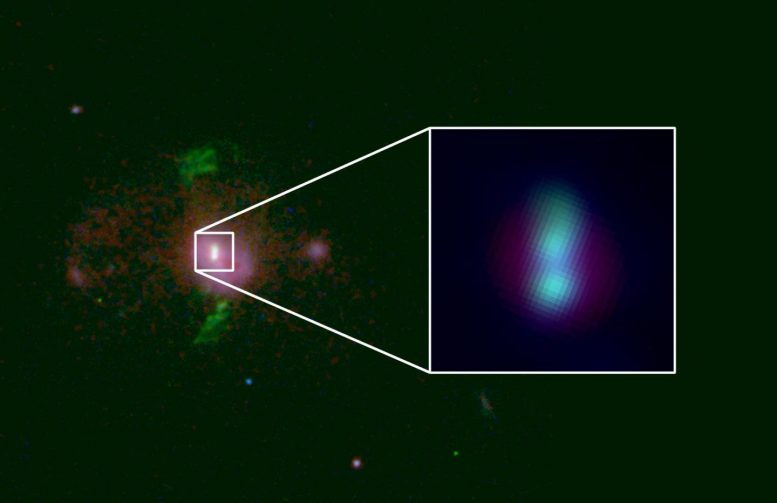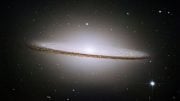
Titanic Twosome: A galaxy roughly 2.5 billion light-years away has a pair of supermassive black holes (inset). The locations of the black holes are lit up by warm gas and bright stars that surround the objects. The finding improves estimates of when astronomers will first detect gravitational wave background generated by supermassive black holes. A.D. Goulding et al./Astrophysical Journal Letters 2019
Astronomers have spotted a distant pair of titanic black holes headed for a collision.
Each black hole’s mass is more than 800 million times that of our sun. As the two gradually draw closer together in a death spiral, they will begin sending gravitational waves rippling through space-time. Those cosmic ripples will join the as-yet-undetected background noise of gravitational waves from other supermassive black holes.
Even before the destined collision, the gravitational waves emanating from the supermassive black hole pair will dwarf those previously detected from the mergers of much smaller black holes and neutron stars.
“Supermassive black hole binaries produce the loudest gravitational waves in the universe,” says co-discoverer Chiara Mingarelli, an associate research scientist at the Flatiron Institute’s Center for Computational Astrophysics in New York City. Gravitational waves from supermassive black hole pairs “are a million times louder than those detected by LIGO.”
The study was led by Andy Goulding, an associate research scholar at Princeton University. Goulding, Mingarelli, and collaborators from Princeton and the U.S. Naval Research Laboratory in Washington, D.C., report the discovery on July 10 in The Astrophysical Journal Letters.
The two supermassive black holes are especially interesting because they are around 2.5 billion light-years away from Earth. Since looking at distant objects in astronomy is like looking back in time, the pair belong to a universe 2.5 billion years younger than our own. Coincidentally, that’s roughly the same amount of time the astronomers estimate the black holes will take to begin producing powerful gravitational waves.
In the present-day universe, the black holes are already emitting these gravitational waves, but even at light speed, the waves won’t reach us for billions of years. The duo is still useful, though. Their discovery can help scientists estimate how many nearby supermassive black holes are emitting gravitational waves that we could detect right now.
Detecting the gravitational wave background will help resolve some of the biggest unknowns in astronomy, such as how often galaxies merge and whether supermassive black hole pairs merge at all or become stuck in a near-endless waltz around each other.
“It’s a major embarrassment for astronomy that we don’t know if supermassive black holes merge,” says study co-author Jenny Greene, a professor of astrophysical sciences at Princeton. “For everyone in black hole physics, observationally this is a long-standing puzzle that we need to solve.”
Supermassive black holes contain millions or even billions of suns’ worth of mass. Nearly all galaxies, including the Milky Way, contain at least one of the behemoths at their core. When galaxies merge, their supermassive black holes meet up and begin orbiting one another. Over time, this orbit tightens as gas and stars pass between the black holes and steal energy.
Once the supermassive black holes get close enough, though, this energy theft all but stops. Some theoretical studies suggest that black holes then stall at around 1 parsec (roughly 3.2 light-years) apart. This slowdown lasts nearly indefinitely and is known as the final parsec problem. In this scenario, only very rare groups of three or more supermassive black holes result in mergers.
Astronomers can’t just look for stalled pairs because long before the black holes are 1 parsec apart, they’re too close to distinguish as two separate objects. Moreover, they don’t produce strong gravitational waves until they overcome the final-parsec hurdle and get closer together. (Observed as they were 2.5 billion years ago, the newfound supermassive black holes appear about 430 parsecs apart.)
If the final parsec problem doesn’t exist, then astronomers expect that the universe is filled with the clamor of gravitational waves from supermassive black hole pairs. “This noise is called the gravitational wave background, and it’s a bit like a chaotic chorus of crickets chirping in the night,” says Goulding. “You can’t discern one cricket from another, but the volume of the noise helps you estimate how many crickets are out there.” (When two supermassive black holes finally collide and combine, they send out a thundering chirp that dwarfs all others. Such an event is brief and extraordinarily rare, though, so scientists don’t expect to detect one any time soon.)
The gravitational waves generated by supermassive black hole pairs are outside the frequencies currently observable by experiments such as LIGO and Virgo. Instead, gravitational wave hunters rely on arrays of special stars called pulsars that act like metronomes. The rapidly spinning stars send out radio waves in a steady rhythm. If a passing gravitational wave stretches or compresses the space between Earth and the pulsar, the rhythm is slightly thrown off.
Detecting the gravitational wave background using one of these pulsar timing arrays takes patience and plenty of monitored stars. A single pulsar’s rhythm might be disrupted by only a few hundred nanoseconds over a decade. The louder the background noise, the bigger the timing disruption and the sooner the first detection will be made.
Goulding, Greene, and the other observational astronomers on the team detected the two titans with the Hubble Space Telescope. Although supermassive black holes aren’t directly visible through an optical telescope, they are surrounded by bright clumps of luminous stars and warm gas drawn in by the powerful gravitational tug. For its time in history, the galaxy harboring the newfound supermassive black hole pair “is basically the most luminous galaxy in the universe,” Goulding says. What’s more, the galaxy’s core is shooting out two unusually colossal plumes of gas. After the researchers pointed the Hubble Space Telescope at the galaxy to uncover the origins of its spectacular gas clouds, they discovered that the system contained not one but two massive black holes.
The observationalists then teamed up with gravitational wave physicists Mingarelli and Princeton graduate student Kris Pardo to interpret the finding in the context of the gravitational wave background. The discovery provides an anchor point for estimating how many supermassive black hole pairs are within detection distance of Earth. Previous estimates relied on computer models of how often galaxies merge, rather than actual observations of supermassive black hole pairs.
Based on the findings, Pardo and Mingarelli predict that in an optimistic scenario there are about 112 nearby supermassive black holes emitting gravitational waves. The first detection of the gravitational wave background from supermassive black holes should therefore come within the next five years or so. If such a detection isn’t made, that would be evidence that the final parsec problem may be insurmountable. The team is currently looking at other galaxies similar to the one harboring the newfound supermassive black hole pair. Finding additional pairs will help them further hone their predictions.
Reference: “Discovery of a Close-separation Binary Quasar at the Heart of a z ~ 0.2 Merging Galaxy and Its Implications for Low-frequency Gravitational Waves” by Andy D. Goulding, Kris Pardo, Jenny E. Greene, Chiara M. F. Mingarelli, Kristina Nyland and Michael A. Strauss, 10 July 2019, The Astrophysical Journal Letters.
DOI: 10.3847/2041-8213/ab2a14








Article needed one correction:
“It’s a major embarrassment for astronomy that we don’t know if supermassive black holes”… even actually exist.
according to the final parsec problem there should be many pairs of large black holes
but as soon as they meet other pairs or single large black holes it becomes a 3 body or more system
which is unstable so pairs should not last too long